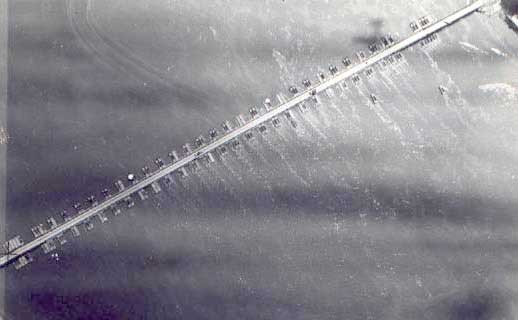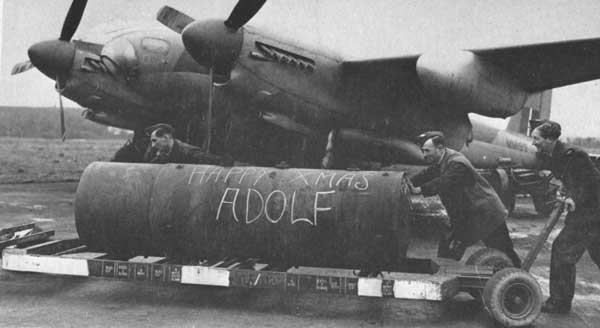OP 19 - SAN BENEDETTO PONTOON BRIDGE
The operation against the pontoon bridge at San Benedetto on the night of October 4/5, 1944 was the third in a series of attacks against this stubborn target.
Because most of the bridges across the River Po had been destroyed, the enemy had been using pontoon bridges to restore vital communications links with his forces holding the Gothic Line. Now that Rimini had been taken by the Allies, it was probable that troops and equipment were crossing the River Po on the pontoon bridge at San Benedetto, nine miles south-east of Mantua. For this reason, 69 aircraft of No. 205 Group were detailed to destroy the bridge on the night of September 22/23, 1944. Nine Wellingtons of 37 Squadron participated in the operation.
Arriving over the target area the aircraft encountered slight, inaccurate heavy and light caliber flak. Illumination was rather scattered, and most crews saw the river bend and nearby island but not the pontoon bridge itself. Green target markers were dropped late, and crews proceeded to make "dummy runs" over the markers to line up their drops on the TI’s. During these runs clouds formed over the target and obscured the green TI’s dropped there. Other markers were attacked by four 37 squadron crews, but these were later revealed to have been dropped some distance east of the target area. The remaining five 37 Squadron aircraft bombed on the glow of incendiaries dropped by other 205 Group aircraft. In total, the Squadron dropped one 4000 pound bomb, one hundred eleven 250 pound bombs and 54 packets of leaflets from 7200 to 8000 feet between 2206 and 2226 hours.

A typical German pontoon bridge as photographed by a B-17 on a daylight raid over the Rhine.
No satisfactory estimate of results could be made at the time of the attack. Three photos were plotted, but these showed the bombing occurred four miles east of the target area. The Group suffered no losses, however, subsequent photo reconnaissance revealed that the bridge was intact and the attack was a complete failure.
On the night of September 30/October 1, 205 Group once more set out to destroy the pontoon bridge at San Benedetto. For this attempt fifty 205 Group aircraft were detailed, fourteen of which were 37 Squadron Wellingtons.
Once again the aircraft were engaged over the target area by slight, inaccurate, heavy and light caliber anti aircraft fire. This time weather and illumination were good and most crews saw the bridge. Two aircraft reported that the center portion of the bridge appeared to be missing, possibly removed by the enemy prior to the attack. Red target indicators were dropped at the south end of the bridge and all fourteen 37 Squadron aircraft attacked, dropping one 4000 pound bomb, two hundred thirty three 250 pound bombs (twenty six of which were equipped with a six hour time delay fuse) and 98 packets of nickels from 7500 to 8400 feet between 2010 and 2014 hours.
Bombing was well concentrated, but it was impossible to see if the bridge was hit due to all the smoke generated by the attack. "K", piloted by F/Sgt. Brookfield, reported overshooting the bridge by fifty yards with his 4000 pound bomb. "B", captained by F/Sgt Wilson and "S", captained by W/O Pike believed their bombs may have hit the bridge but were not certain. Twelve photos were plotted, but the majority appeared to have bombed well south of the markers. The Wing "best photo’ was won by "T", piloted by F/Sgt. Robson of 37 Squadron. There were no losses.
Unfortunately, once again photo reconnaissance proved that the attack was unsuccessful: the bridge was still intact, undamaged, and very much in use by the enemy. Yet another operation against the bridge was required. This was carried out by fifty five aircraft of 205 Group on the night of October 4/5, 1944.
MacIsaac and crew, having returned from their rest period, were one of fifteen 37 Squadron crews detailed for this third attack on the San Benedetto pontoon bridge. They took off from the airfield at Tortorella in Wellington Mk.X LP843 "K" at 1920 hours carrying one 4000 pound cookie and seven packets of nickels.
Wellington "L" captained by F/Sgt. Brookfield was forced to return early due to excessive fuel consumption and high oil temperature in his aircrafts port engine.
Bad weather developed en route to the target, and while there were some clear patches in the target area that might enable crews to identify the target, many made several dummy runs in an unsuccessful attempt to lose height and break through the cloud cover. Green target indicators were dropped near the southern end of where the bridge should have been - the bridge itself was apparently not in position at all, most likely having been removed by the enemy in anticipation of the attack. The green TI’s were quickly obscured by cloud in any case, and bombing was subsequently very scattered with no result being observed.
Opposition was heavier than on previous attempts, with intense light caliber flak and slight heavy caliber flak, both with much improved accuracy. One 205 Group aircraft and its crew were lost to AA fire over the target.
MacIsaac, the green TI’s not visible and finding himself in ten tenths cloud, bombed by dead reckoning on the estimated position of the bridge. He dropped his "cookie" at 2205 hours from 6000 feet on a heading of 310 degrees. He reported seeing the massive blast of the 4000 pound bomb but was unable to report any results due to the thick cloud cover.

Ground crew push a 4000 pound high capacity bomb, or "cookie", towards the bomb bay of Mosquito Mk.XVI
In total the Squadron dropped one 4000 pound bomb, twenty six 500 pound bombs, one hundred eighty two 250 pound bombs and 98 packets of leaflets from 2750 to 7900 feet between 2200 and 2217 hours. Of the 500 pound bombs ten were equipped with a 6 hour time delay, seven with a 12 hour delay, and nine with a 36 hour time delay fuse.
Five photos were taken of which four were plotted near the estimated position of the bridge, however, none revealed any ground detail that might serve to estimate if any damage to the bridge had been done. Indeed, at the end of this operation it seemed likely that the bridge was, in fact, not even in place on this night.
Later reconnaissance showed that, once again, the bridge was intact and serviceable following the attack.
MasIsaac returned safely to base at 0032 hours.
In addition to the aircraft lost in this attack, a Wellington of 205 Group detailed to mine the Danube on this night failed to return from operations. All on board were killed.
The pontoon bridge at San Benedetto was visited again by fifteen aircraft of 205 Group on the night of October 21/22, 1944, when it was finally destroyed.

